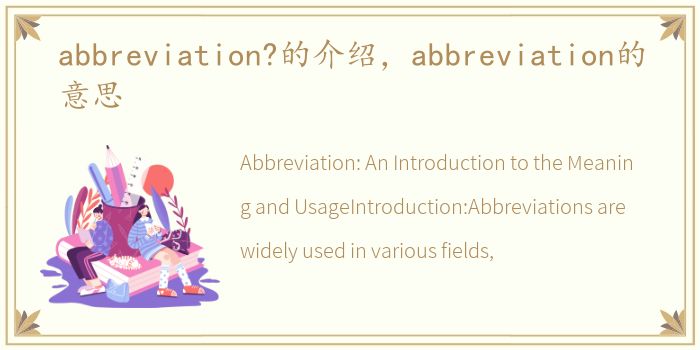abbreviation?的介绍,abbreviation的意思

Abbreviation: An Introduction to the Meaning and Usage
Introduction:
Abbreviations are widely used in various fields, including academia, business, and everyday communication. They play a crucial role in simplifying complex terms and phrases, saving time and effort for both speakers and writers. This article aims to provide an overview of abbreviations, their meaning, and their significance in different contexts.
The Meaning of Abbreviation
Abbreviation refers to the shortened form of a word or phrase. It is created by omitting one or more letters or syllables from the original term while retaining its essential meaning. For example,"etc."is an abbreviation for the Latin phrase"et cetera,"meaning"and so forth."Abbreviations can be formed using initial letters (e.g.,"USA"for the United States of America), a combination of letters (e.g.,"NASA"for the National Aeronautics and Space Administration), or a combination of letters and numbers (e.g.,"COVID-19"for coronavirus disease 2019). The purpose of using abbreviations is to convey information concisely and efficiently.
The Significance of Abbreviations
Abbreviations have several significant advantages. Firstly, they enhance communication efficiency by reducing the length of words or phrases. In academic writing, for instance, using abbreviations such as"e.g."(for example) or"i.e."(that is) allows authors to provide examples or clarify meanings without repeating lengthy explanations. Secondly, abbreviations save time and effort in both spoken and written language. In business settings, professionals often use abbreviations like"CEO"(Chief Executive Officer) or"FYI"(For Your Information) to convey information quickly during meetings or in emails. Lastly, abbreviations contribute to the development of specialized terminology within specific fields. For instance, medical professionals use abbreviations like"MRI"(Magnetic Resonance Imaging) or"CPR"(Cardiopulmonary Resuscitation) to communicate efficiently within their domain.
Considerations for Using Abbreviations
While abbreviations offer numerous benefits, it is essential to use them appropriately and consider the context in which they are used. Firstly, it is crucial to ensure that the abbreviation is widely recognized and understood by the intended audience. Using obscure or unfamiliar abbreviations may lead to confusion or misinterpretation. Secondly, when using abbreviations in formal writing, it is advisable to provide the full term or phrase upon first mention, followed by the abbreviation in parentheses. This practice helps readers understand the meaning of the abbreviation and avoids any ambiguity. Lastly, it is important to avoid excessive use of abbreviations, as this can hinder comprehension and make the text appear overly technical or jargon-filled.
Conclusion:
Abbreviations are an integral part of modern communication, enabling concise and efficient expression of ideas. They simplify complex terms, save time, and contribute to specialized terminology within various fields. However, it is crucial to use abbreviations judiciously, considering the audience and context. By understanding the meaning and significance of abbreviations, individuals can effectively utilize them to enhance communication in both professional and everyday settings.
推荐阅读
- 魅蓝note6刷机教程,魅族note3刷机教程
- 女生编发技巧,女生的日常编发教程
- 苹果的6s点不见了iphone6s点集在哪里
- 隐形眼镜护理液可以带飞机吗,隐形眼镜护理液能带上飞机吗
- 苹果悬浮窗怎么打开录屏,苹果悬浮窗怎么打开
- 搜狗输入法怎么设置字体大小和字号,搜狗输入法怎么设置字体大小
- 手机网速太慢怎么办,修改一个地方飞快
- 手游我的世界天堂门怎么做,我的世界手机版天堂门怎么做
- 电脑软件打不开双击没反应,双击IE图标无反应,IE浏览器打不开解决办法
- ppt设置单词配读音,PPT为课件中的单词配上读音
- 固态硬盘安装后如何分区,详解固态硬盘分区方法
- 国6排放的车能加92号汽油吗,国6排放标准实施时间什么时候
- 怎么免费注册iPhone,Apple_ID
- 微信在哪里查看自动扣费项目,手机微信自动扣费怎么查看与关闭
- 2021年中级经济师网上报名(2021全国经济师考试报名入口)
- 现在纯碱价格是多少 纯碱网最新价格报价
- 怎么设置qq背景,如何设置手机qq的聊天背景为默认的背景
- 2021醉酒驾车的处罚标准是什么,醉酒驾驶怎么处罚2022年,醉酒驾车的处罚标准是什么
- 夏普空调维修服务(夏普空调维修)
- 笔记本电脑聚合物电池和锂电池哪个好,修复笔记本聚合物电池的方法与技巧
